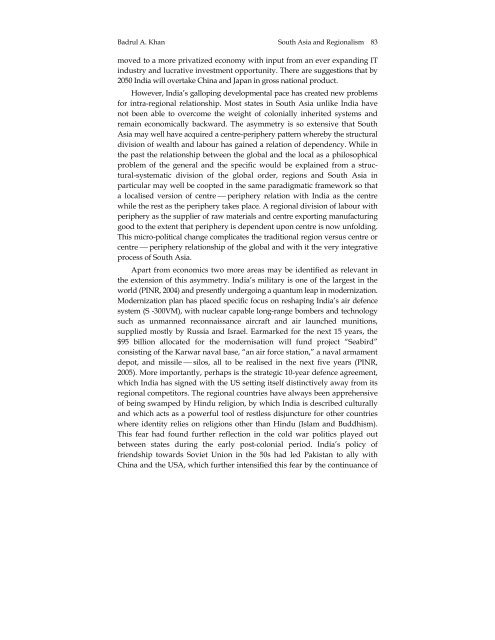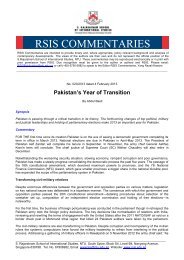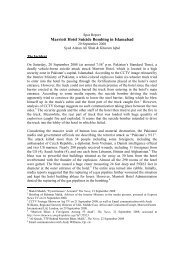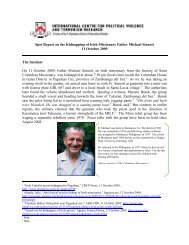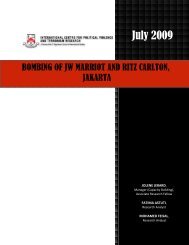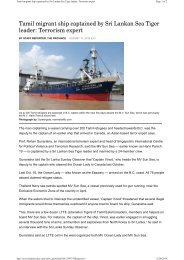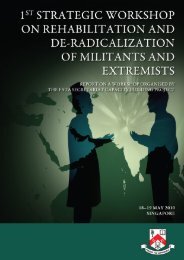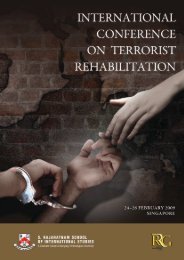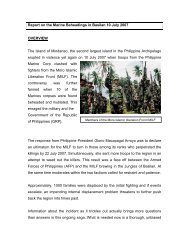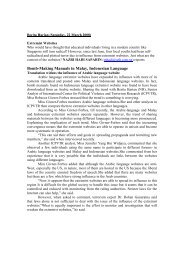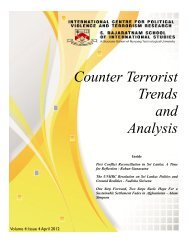Peace and Security Review, Vol.1 No. 2 - International Centre for ...
Peace and Security Review, Vol.1 No. 2 - International Centre for ...
Peace and Security Review, Vol.1 No. 2 - International Centre for ...
You also want an ePaper? Increase the reach of your titles
YUMPU automatically turns print PDFs into web optimized ePapers that Google loves.
Badrul A. Khan South Asia <strong>and</strong> Regionalism 83<br />
moved to a more privatized economy with input from an ever exp<strong>and</strong>ing IT<br />
industry <strong>and</strong> lucrative investment opportunity. There are suggestions that by<br />
2050 India will overtake China <strong>and</strong> Japan in gross national product.<br />
However, India’s galloping developmental pace has created new problems<br />
<strong>for</strong> intra-regional relationship. Most states in South Asia unlike India have<br />
not been able to overcome the weight of colonially inherited systems <strong>and</strong><br />
remain economically backward. The asymmetry is so extensive that South<br />
Asia may well have acquired a centre-periphery pattern whereby the structural<br />
division of wealth <strong>and</strong> labour has gained a relation of dependency. While in<br />
the past the relationship between the global <strong>and</strong> the local as a philosophical<br />
problem of the general <strong>and</strong> the specific would be explained from a structural-systematic<br />
division of the global order, regions <strong>and</strong> South Asia in<br />
particular may well be coopted in the same paradigmatic framework so that<br />
a localised version of centre ⎯ periphery relation with India as the centre<br />
while the rest as the periphery takes place. A regional division of labour with<br />
periphery as the supplier of raw materials <strong>and</strong> centre exporting manufacturing<br />
good to the extent that periphery is dependent upon centre is now unfolding.<br />
This micro-political change complicates the traditional region versus centre or<br />
centre ⎯ periphery relationship of the global <strong>and</strong> with it the very integrative<br />
process of South Asia.<br />
Apart from economics two more areas may be identified as relevant in<br />
the extension of this asymmetry. India’s military is one of the largest in the<br />
world (PINR, 2004) <strong>and</strong> presently undergoing a quantum leap in modernization.<br />
Modernization plan has placed specific focus on reshaping India’s air defence<br />
system (S -300VM), with nuclear capable long-range bombers <strong>and</strong> technology<br />
such as unmanned reconnaissance aircraft <strong>and</strong> air launched munitions,<br />
supplied mostly by Russia <strong>and</strong> Israel. Earmarked <strong>for</strong> the next 15 years, the<br />
$95 billion allocated <strong>for</strong> the modernisation will fund project “Seabird”<br />
consisting of the Karwar naval base, “an air <strong>for</strong>ce station,” a naval armament<br />
depot, <strong>and</strong> missile ⎯ silos, all to be realised in the next five years (PINR,<br />
2005). More importantly, perhaps is the strategic 10-year defence agreement,<br />
which India has signed with the US setting itself distinctively away from its<br />
regional competitors. The regional countries have always been apprehensive<br />
of being swamped by Hindu religion, by which India is described culturally<br />
<strong>and</strong> which acts as a powerful tool of restless disjuncture <strong>for</strong> other countries<br />
where identity relies on religions other than Hindu (Islam <strong>and</strong> Buddhism).<br />
This fear had found further reflection in the cold war politics played out<br />
between states during the early post-colonial period. India’s policy of<br />
friendship towards Soviet Union in the 50s had led Pakistan to ally with<br />
China <strong>and</strong> the USA, which further intensified this fear by the continuance of<br />
<strong>Vol.1</strong>, <strong>No</strong>.2 2008 pp.77-93


